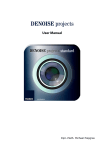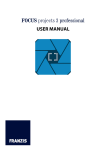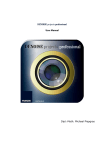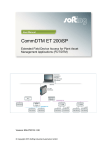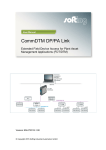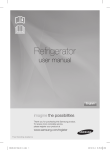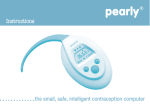Download user manual - PROJECTS SOFTWARE
Transcript
HDR projects 3 USER MANUAL System Requirements Windows 8.1/8/7/Vista, 32/64 bit, Dual Core Processor, 2 GB RAM, 2 GB HDD, Screen Resolution 1280 x 1024 Pixels, Graphic Card: Di‐ rectX‐8‐compatible, 128 MB, 32 bit colour depth Mac OS X (10.7 and higher), 64 bit, Intel Processor/G5, 2 GB RAM, 2 GB HDD, Screen Resolution 1280 x 1024 Pixels Internet connection required for software activation. Installation on Windows The start screen for the installation will normally be automatically displayed. If the auto‐start function of your CD/ DVD drive is deac‐ tivated, open the start screen manually by going to My Computer, double clicking on the CD/DVD drive symbol and then the .exe file to start. Choose German, English or French as setup language and follow the installation assistant’s instructions. During the installation, you will be asked if you would like to install the Adobe® Photoshop plug‐in. If you agree to this, you can use HDR projects 3 as a plug‐in for Adobe® Photoshop. Alternatively, the plug‐ins can also be manually copied into the Adobe® Pho‐ 2 toshop plug‐in folder. Select the plug‐in entry folder in the CD start menu to open it. Installation on Mac Load your CD into your CD/DVD drive and open the installation menu through the desktop. Drag the HDR projects 3 file into the program link. To use the Ado‐ be® Photoshop plug‐ins, open the Adobe® Photoshop plug‐ins fold‐ er and copy the appropriate plug‐ins into your Photoshop plug‐ins folder. You can now use HDR projects 3 to edit your photos! Registration Upon opening HDR projects 3 for the first time you will be request‐ ed to register the program. Proceed according to the following: 1. Install HDR projects 3 as described. 2. Input the serial number. For the box version, this can be found in the accompanying booklet. If you have the downloadable version, the serial number will have been sent to you by email directly after the purchase. 3 3. Finally, click on the “Activate now” button. The software has now been successfully activated. Note: Using the same serial number, HDR projects 3 can be in‐ stalled on up to two computers. A second serial number is not necessary. For an additional installa‐ tion on a different computer, enter the serial number and then click on “Activate now”. The information on the following pages should enable you to start working with the software immediately. You will learn how to edit an image step by step. 4 The Start Screen On the start screen you can find the tools for searching and loading images and loading existing projects. From left to right: Image data browser This tool allows you to search through folders for images. A preview of the images found will be displayed and you can import them directly by right‐clicking on them and using the context menu that pops up. Load single images and exposure series Use this buttons to load images or exposure series directly. All common image formats, camera RAW formats and HDR image formats are supported. 5 Open project You can load existing projects by clicking on this button. Batch processing Click on this button to go to batch processing. Here you can process several images automatically. Load example projects 1‐3 With one of these three buttons you can open and work on a photo series in order to familiarize yourself with the pro‐ gram, without having to load your own photo series. 6 Drag & Drop Functions The software has a powerful drag and drop function that can de‐ cide, depending on the file that you drop into the program window, what to do with the file: - Single images will be loaded directly - Folders will open the image browser - Project files will be opened directly - Addons (.praddon) will be detected and imported automat‐ ically HDR Creation Editing the exposure bracketing is the first step towards an impres‐ sive HDR final image. In order to go to this area, select „Edit expo‐ sure bracketing“ in the upper toolbar. 7 Exposure Bracketing To the left of the exposure bracket‐ ing, you can see the whole expo‐ sure bracketing with each image and a weighting mask created by the HDR algorithm being displayed. Here you can exclude images from the calculation, change the global weight or the lighting and re‐sort the image sequence. You can add syn‐ thetic images to the exposure bracketing that are always created from the master image. 8 HDR Algorithms HDR projects 3 offers 9 different HDR calculation methods (algo‐ rithms) which you can find in the upper right of the screen. The algorithm “Average“ creates the simple aver‐ age of your image se‐ quence and lets you compare image sharp‐ ness without determin‐ ing the luminance per pixel. Don’t get hung up on the technical terminology. Just go ahead and try the different algorithms by clicking on them, and decide which one best suits your image. Below the algorithms you have the parameter area for every selected algo‐ rithm. There are also tooltips here next to the controls, which will give you more useful infor‐ mation. 9 Denoising: Denoising directly affects the HDR image and indicates its strength in a percentage. A value of 0% leads to no pixels with noise being deleted; while a high value will denoise the HDR image strongly. The latter automatically leads to an image with less sharpness. Smoothing: Smoothing influences the weighting matrixes that emerge from the HDR algorithms. It indicates the smoothing of images depending on image resolution in a percentage. A value of 50% means that the weight matrixes will be smoothed over with an expansion of 50% of the resolution using a Gaussian blur. Night/Daytime: With this option you can adjust the HDR algorithm to an image tak‐ en at night or during the day. Move the control panel to the left (night) if your exposure bracketing is closer to an image taken at night; move it to the right (day) if it is more like an image taken dur‐ ing the day. Halo adjustment: This option deals with a typical problem of HDR creation: the crea‐ tion of halo effects (HDR shadows). Halo adjustment is a special mathematical method which allows you to push the HDR weighting in a certain direction. Low halo adjust‐ ment gives more weight to bright areas of the image and high halo adjustment gives more weight to darker parts of the image. 10 HDR Painter Activate the button „Edit weightings” (brush icon) in the upper toolbar to open the HDR painter for area retouching. If you have activated area retouching, a colour display of your expo‐ sure bracketing will be shown. In our example, the exposure bracketing consists of three images that were assigned to the colours red, green and blue. These col‐ ours indicate which image area has been created from which image. In order to manually change the weighting for a certain area, for example from the blue (background) image, which means that only the background image will be used during the calculation of the HDR fusion, select the blue colour from the retouching toolbar, the “Increase weighting” tool and the stance (in order to decrease the weighting of all the other images). With this technique you can change and edit your HDR image as you wish, delete moving objects (ghosting) or assign certain areas to your desired exposure. 11 RAW Module The RAW module is a RAW processor integrated into the program. Simply click on the RAW symbol in the tool list to access this func‐ tion. There are 9 different adjustment options in this module: ‐ White balance ‐ Denoising & Sharpness ‐ Colour Balance ‐ Exposure ‐ Detail ‐ Colour ‐ Palette ‐ Distortion ‐ General Note: Editing is equally as possible with JPEG and TIF files. 12 Post Processing As soon as you have loaded an image or a project into the software the image editing area will be displayed. Here you can configure all the settings for individual image processing. Selecting Default Settings On the left of the main screen you can find the settings and control functions. The import/export area underneath lets you import or export de‐ fault settings. You can trade as many default settings as you like with your friends and colleagues. By left‐clicking on the preview of a default setting you can open the image in the middle of the screen for the main processing. 13 Expert Mode On the right of the main screen you can find the “Expert mode” window. The tab “finalise” includes the following functions: Magnifying Glass The magnifying glass shows you a 1:1 comparison between the orig‐ inal and edited images. Hold your cursor over any desired point on the image. You can fix the magnification with the “L” key (Lock) to monitor a specific area while editing it. When the area is fixed, a white dotted line will appear around the edge of the magnifying glass Intelligent Colour Space (SCA method) The SCA method (Smart Colour Space Adaption) activates the intel‐ ligent colour space in all calculations of the software and creates higher detail structures in the colours while increasing calculation times. 14 Light effect of the tone mapping Determine if the tonal value compression is based on daylight, dawn or an image taken by night. Note: If you do not select tone mapping as an effect, you won’t see any changes. Optimisation Assistant The optimisation assistant is a tool that remembers your prefer‐ ences. Values for optimised denoising, tonal values, clarity, dynamic and image sharpness will be automatically determined for the current focus stack. These values can also be changed later on. If you save an image with a different setting, these values will be calculated into an individual trend that will be made available to you for the next stack. This trend will be indicated on the sliders by a bright area setting it apart from the calculated optimum. In this way, the optimisation assistant evolves over time to your preferred image style. Scratch & Sensor Spot Correction Scratch and sensor spot correction can be found on the right hand side in the “Finalise” window, down at the bottom, with good rea‐ son. A scratch and sensor spot correction should always be the last task to be performed. 15 As soon as the correction has been activated, a new window will open. The work area is in the middle and the settings can be adjust‐ ed on the right side. Choosing the “expert” tab, you can edit effects in different areas of the interface. At the top of the expert mode panel you can see a list of all the available post‐processing filters. Double‐clicking on one of them will add it to the end of the list of effects you have selected. If you want to change the values of a single effect within the list, select the effect by left‐clicking on it. You can now see an area with all the parameters for the effect you have chosen below the list of selected effects. Here you can choose the settings for the processing method with the corresponding opacity, effect intensity, colours, positions and many more. Please also note that you have a context menu available within the list of selected effects. In order to get the hang of these values you can either take a look at the tooltips, or just click on some default settings and see how the effects and their respective parameters change. 16 Another effective option for setting up parameters is the real‐time preview. To the left of every slider in the parameter area you can find a „play” button. Clicking on it will make the respective slider go in one direction and then in the other. If you have found your desired setting this way, simply press “Esc” on your keyboard to apply this value to your image. 17 External Programs There are two steps to transfer an image to an external program. The projects Interface: All programs in the projects product family are automatically regis‐ tered. Images can be directly transferred to the desired program using the dropdown list. A transfer BLACK & WHITE projects 3 is selected here as an exam‐ ple. The Main Interface: The main interface for external programs can be configured solely through settings (Menu ‐> Extras ‐> Settings). The path for external editors (General, Photoshop CC, Lightroom, Photoshop Elements) can be configured here. You can transfer a photo to one of the four external editors with the tool list: Simply click on the arrow be‐ side the transfer button and then on one of the four pro‐ grams to transfer the image. 18 The Timeline The timeline displays all of your currently available undo steps. Every time you create an undo step, an entry will be added to the timeline. You can jump to this undo step anytime you like by clicking on “Revert to restore point” (underneath every image in the timeline). In addition, you can delete restore points from the timeline if you don’t need them anymore. Note: Undo points save the whole project with all weightings and source images. Therefore, they take up a lot of space on your hard disk drive. Use them with care. The same is true for saving projects, as the timeline will be saved with every save file that you create. (You can switch this function off in the options.) Batch Processing Batch processing is accessible through “Menu ‐> Extras ‐> Batch processing”. Once the batch processing has been activated, a window with vari‐ ous setting options as well as a preview of the images located in the source folder will appear. At the top of the screen you can choose the source folder for the batch processing and enter the name of the destination folder, where the results should be saved. You can also set what file type the images should be saved as. For example, when you only want to select RAW files from the cur‐ rent folder, select “Camera RAW”. 19 In the Processing settings, you can choose HDR default settings and post‐processing filters for your images. After you have arranged all the settings accordingly, click on the “Start” button at the bottom right and the batch processing will convert the selected images. Saving Final Images You can save your final images either with the corresponding button in the toolbar on the upper left, by selecting “Save final image” in the File menu, or by using the respective hot key (Ctrl+S). 20 Hotline/Support If you have questions regarding the installation, problems or errors of the software, please contact the FRANZIS customer support team. E-Mail: [email protected] Phone (Monday to Friday 12am to 6pm): +49 (0)180 30 02 644 (0,09 EUR/minute from German landlines, prices from mobile phones might vary) Fax: +49 (0)180 300 26 45 (0,09 EUR/minute from German landlines, prices from mobile phones might vary) Please understand that your questions can only be answered directly by FRANZIS customer support. This is to give us the opportunity to constantly enhance our customer service for you and to make sure that you receive only the most qualified answers to all of your questions as fast as possible. This is how our customer support works best: Please have the most important details about your computer and about our product at hand when you call our customer support. These include: Name of the product Product ISBN (which you can find on the back of the packaging, above the easy to spot barcode). Operating system of your computer Technical details of your PC including all your peripheral devices Copyright Franzis Verlag GmbH has prepared this product with the greatest possible care. Please read the following conditions: All the programs, routines, controls, etc., contained in this data media or within this download are protected by their respective authors or distributors as mentioned in the respective programs. The purchaser of this data media or of this download is authorised to use those programs, data or data groups that are not marked as shareware or public domain for his/her own purposes within the provisions of their designated use. He/she is authorised to use programs or parts of programs that are marked as shareware, freeware or public domain within the restrictions given by the respective programs or parts of programs. A reproduction of programs with the intent of distributing data media containing programs is forbidden. Franzis Verlag GmbH holds the copyright for the selection, arrangement and disposition of the programs and data on these data media or these downloads. The data and the programs in this data media or within this download have been checked with the greatest possible care. Considering the large quantity of data and programs, Franzis assumes no warranty for the correctness of the data and a flawless functioning of the programs. Franzis Verlag GmbH and the respective distributors do not undertake neither warranty nor legal responsibility for the use of individual files and information with respect to their economic viability or their fault-free operation for a particular purpose. Additionally, there is no guarantee that all the included data, programs, icons, sounds and other files are free to use. Therefore the publisher cannot be held liable for a possible breach of third party copyrights or other rights. Most product designations of hard- and software and company names and labels mentioned in this product are registered trademarks and should be treated as such. The product designations used by the publisher are basically as the manufacturer describes them. © 2014 Franzis Verlag GmbH, Richard-Reitzner-Allee 2, 85540 Haar, München 21























